 W
WAldborough Castle was located near the village of Aldborough, North Yorkshire, England.
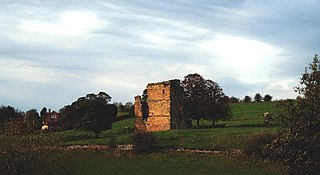 W
WAyton Castle is a ruined Grade I listed 14th century pele tower castle near West Ayton, North Yorkshire, England.
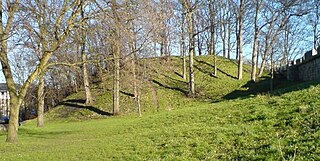 W
WBaile Hill is a man-made earth mound in the Bishophill area of York, England. It is the only remaining feature of what was known as the Old Baile.
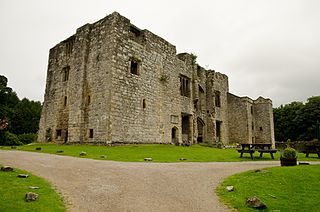 W
WBarden Tower is a ruined building in the Parish of Barden, in Wharfedale, North Yorkshire, England. The tower was used as a hunting lodge in the 15th and 16th centuries, and despite a renovation in the 1650s, it fell into disrepair in the 18th century. The tower is now part of the Bolton Estate and is listed as a medieval fortified tower. Along with other buildings on the Bolton Estate, it is a focal point and many people visit the tower. It is also a way marker on the 100-mile (160 km) Lady Anne's Way long distance path.
 W
WBolton Castle is a 14th-century castle located in Wensleydale, Yorkshire, England. The nearby village Castle Bolton takes its name from the castle. The castle is a Grade I listed building and a Scheduled Ancient Monument. The castle was damaged in the English Civil War, and “slighted” afterwards, but much of it survived. It has never been sold and is still in the ownership of the descendants of the Scrope family.
 W
WBurton in Lonsdale Castle was in the village of Burton in Lonsdale in North Yorkshire, England.
 W
WCawood Castle is a grade I listed building in Cawood, a village in North Yorkshire, England. The surviving fifteenth-century structures formed part of a fortified medieval palace belonging to the Archbishops of York, which was dismantled in the aftermath of the English Civil War.
 W
WCrayke Castle is a Grade I listed 15th-century castle in Crayke, North Yorkshire, England. The castle consists of a restored 15th-century four-storey tower house with attached outbuildings to the rear and a separate ruined 15th-century tower, the "New Tower". It is situated on Church Hill in the village of Crayke.
 W
WDanby is a village and civil parish in the Scarborough district of North Yorkshire, England. According to the 2001 UK census, Danby parish had a population of 1,411, a reduction on the 2001 UK census figure of 1,515. The statistician Karl Pearson spent a lot of time there.
 W
WDuffield Castle lay on the flood plain of the River Derwent in the parish of North Duffield in the English county of North Yorkshire. It was documented in 1320. Duffield Castle was owned by John Hussey, 1st Baron Hussey of Sleaford, who was executed in 1537. It is uncertain when the castle was demolished, but all that remains today are earthworks marking the position of the mound and ditches. A farmhouse was later built on the site.
 W
WGilling Castle is a grade I listed castle near Gilling East, North Yorkshire, England.
 W
WWest Harlsey is a hamlet and civil parish in the Hambleton district of North Yorkshire, England. The population as taken at the 2011 Census was less than 100. Details are included in the civil parish of Winton, Stank and Hallikeld. It is situated near the A19 road, 3 miles north east of Northallerton.
 W
WHelmsley Castle is a medieval castle situated in the market town of Helmsley, within the North York Moors National Park, North Yorkshire, England.
 W
WHornby Castle is a grade I listed fortified manor house on the edge of Wensleydale between Bedale and Leyburn, in the county of North Yorkshire, England.
 W
WJohn O'Gaunt's Castle was a royal hunting lodge in the West Riding of Yorkshire in England.
 W
WKilton Castle is a ruined castle overlooking the valley of Kilton Beck, near to the village of Kilton in the historic county of the North Riding of Yorkshire in England. The castle was built in the 12th century and was described as being in a ruinous state by the 14th century, with it being totally abandoned by the 16th century. Kilton Castle was owned by several noble families who hailed from the area; de Brus, de Kilton, Autrey, de Thweng, de Lumley.
 W
WKnaresborough Castle is a ruined fortress overlooking the River Nidd in the town of Knaresborough, North Yorkshire, England.
 W
WMalton Castle was a castle in Malton, North Yorkshire, England. A wooden motte and bailey castle was built by William Tyson, lord of Alnwick in the 11th century, on the site of the Roman fort of Derventio Brigantum. The castle was given to Eustace fitz John, who rebuilt it in stone.
 W
WMiddleham Castle is a ruined castle in Middleham in Wensleydale, in the county of North Yorkshire, England. It was built by Robert Fitzrandolph, 3rd Lord of Middleham and Spennithorne, commencing in 1190. The castle was the childhood home of King Richard III, although he spent very little of his reign there. The castle was built to defend the road from Richmond to Skipton, though some have suggested the original site of the castle was far better to achieve this than the later location. After the death of King Richard III the castle remained in royal hands until it was allowed to go to ruin in the 17th century. Many of the stones from the castle were used in other buildings in the village of Middleham.
 W
WMulgrave Castle refers to one of three structures on the same property in Lythe, near Whitby, Yorkshire, England. One of these, known as the "old" or "ancient" castle, was by legend founded by Wada, a 6th-century ruler of Hälsingland. The second castle, caput of the feudal barony of Mulgrave, was of Norman construction and remained active until destroyed by order of Parliament in 1647. The third is a country house which was constructed by Lady Catherine Darnley and passed in 1718 by marriage into the Phipps family, when her daughter Lady Catherine Annesley married William Phipps. The Phipps family later held the titles of Baron Mulgrave, Earl of Mulgrave and Marquess of Normanby.
 W
WPickering Castle is a motte-and-bailey fortification in Pickering, North Yorkshire, England.
 W
WRavensworth Castle is a ruined 14th-century castle in the village of Ravensworth, North Yorkshire, England. It has been designated a Grade I listed building by English Heritage.
 W
WRichmond Castle in Richmond, North Yorkshire, England, stands in a commanding position above the River Swale, close to the centre of the town of Richmond. It was originally called Riche Mount, 'the strong hill'. The castle was constructed by Alan Rufus from 1071 onwards following the Norman Conquest of England, and the Domesday Book of 1086 refers to 'a castlery' at Richmond.
 W
WRougemont Castle in the manor of Harewood, in the parish of Weeton, North Yorkshire, England, is a ruined ringwork castle, now largely hidden within over-grown woodland, located to the south east of the village of Weeton, above the north bank of the River Wharfe, where the river turns in a right-angle at its confluence with Weeton Beck. No above-ground structure survives but the earthwork features remain visible of building platforms, ditch system, outer enclosure and fish ponds.
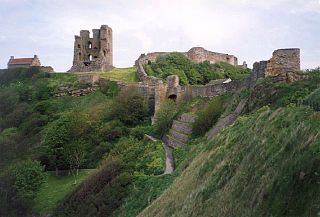 W
WScarborough Castle is a former medieval Royal fortress situated on a rocky promontory overlooking the North Sea and Scarborough, North Yorkshire, England. The site of the castle, encompassing the Iron Age settlement, Roman signal station, an Anglo-Scandinavian settlement and chapel, the 12th-century enclosure castle and 18th-century battery, is a scheduled monument of national importance.
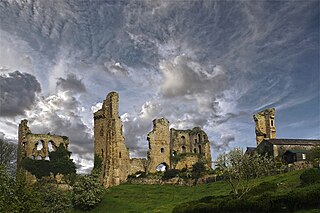 W
WSheriff Hutton Castle is a ruined quadrangular castle in the village of Sheriff Hutton, North Yorkshire, England.
 W
WSkipton Castle is a Grade I Listed medieval castle in Skipton, North Yorkshire, England. It was built in 1090 by Robert de Romille, a Norman baron, and has been preserved for over 931 years.
 W
WSouth Cowton Castle is a 15th-century fortified dwelling house in the Richmondshire district of North Yorkshire, England. It is situated on the land that was once the medieval village of South Cowton.
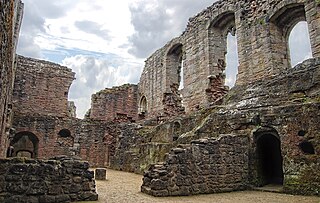 W
WSpofforth Castle in the village of Spofforth, North Yorkshire, England was a fortified manor house, ruined during the English Civil War and now run by English Heritage as a tourist attraction.
 W
WTopcliffe Castle was located near the village of Topcliffe, North Yorkshire, England.
 W
WUpsall Castle is a fourteenth-century ruin, park and manor house in Upsall, in the Hambleton district of North Yorkshire, England.
 W
WWhorlton Castle is a ruined medieval castle situated near the abandoned village of Whorlton in North Yorkshire, England. It was established in the early 12th century as a Norman motte-and-bailey associated with the nearby settlement. The castle is an unusual example of a motte-and-bailey that remained in use throughout the Middle Ages and into the early modern period.
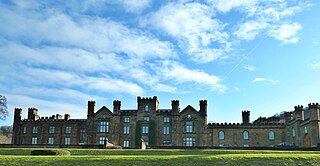 W
WWilton Castle is an early 19th-century mansion, built on the site of a medieval castle, now converted into luxury residential apartments, situated at Wilton, in Redcar and Cleveland, North Yorkshire, England. It is a Grade II listed building.
 W
WYork Castle is a fortified complex in the city of York, England. It consists of a sequence of castles, prisons, law courts and other buildings, which were built over the last nine centuries on the south side of the River Foss. The now-ruined keep of the medieval Norman castle is commonly referred to as Clifford's Tower. Built originally on the orders of William I to dominate the former Viking city of Jórvík, the castle suffered a tumultuous early history before developing into a major fortification with extensive water defences. After a major explosion in 1684 rendered the remaining military defences uninhabitable, York Castle continued to be used as a jail and prison until 1929.